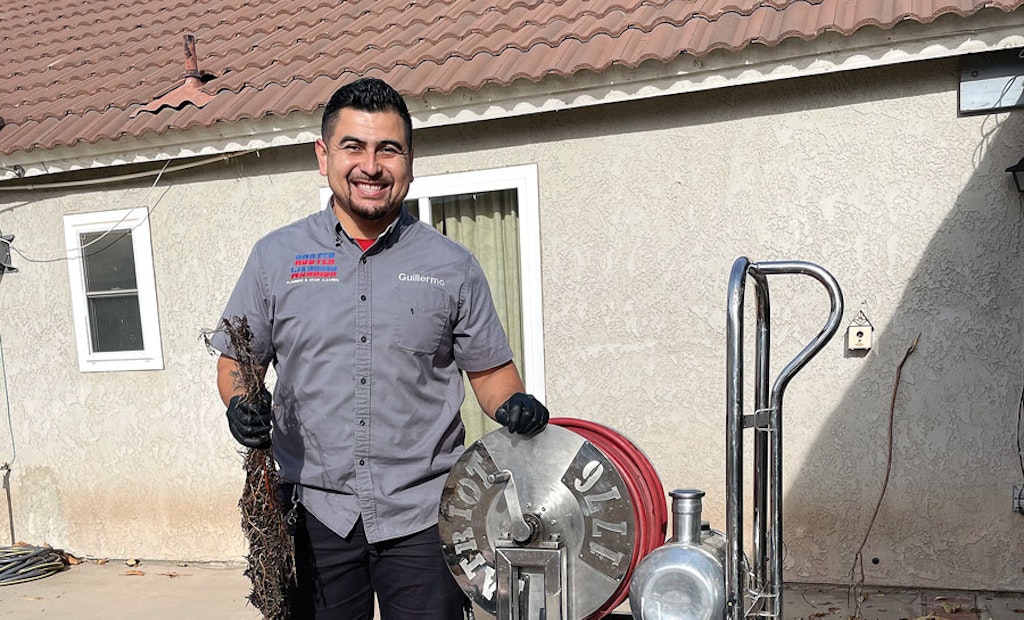Interested in Cleaning?
Get Cleaning articles, news and videos right in your inbox! Sign up now.
Cleaning + Get AlertsThere was a time when Guillermo Alvarez was socking away money to buy a trailer-mounted water jetter so his company, Rooter Warrior Plumbing & Drain Cleaning, could someday clean larger drainlines.
But that plan changed dramatically after he invested in a Patriot 1776 HD dolly-mounted jetting machine, manufactured by Patriot Sewer Equipment & Repair.
“I figured we’d use it for a year or two, then build up enough capital to move up into a trailer jetter,” says Alvarez, who established the company in 2018 in Riverside, California, about 55 miles east of downtown Los Angeles. “But now I can’t see spending that kind of money when this jetter keeps up with everything we need to do.
“I’ll admit I was a little doubtful at first,” adds Alvarez, who runs four service vehicles and employs six people. “The only jetters I’d ever run before were trailer jetters, and I didn’t see how this smaller machine would work as well. But after I watched a demo, I put an order in right away.”
Furthermore, the price tag was about $13,000 — significantly less than what a trailer jetter would cost.
“Being a younger company, I didn’t want a big expenditure like a trailer jetter,” he explains. “But I still needed a jetter to handle different kinds of jobs. We have a lot of terra cotta and clay pipes around here, so there are a lot of root intrusions, which a jetter handles better.”
Bringing the muscle
The chief attraction for Alvarez was the jetter’s combination of portability and power. Its compact design (55 inches tall with the dolly handle, 43 1/2 inches without it, 38 inches long and 25 inches wide) makes it easy to maneuver.
The machine weighs 345 pounds, so Alvarez uses a winch to load and unload it. But the dolly — which features solid, 13-inch-diameter, flat-free polyurethane-foam tires — makes it easy to move the jetter around and access places a trailer jetter can’t. Moreover, the handle comes off and self-stows on the machine, which makes it easier to store in service vehicles.
“In the neighborhoods where we work the most, a lot of drainlines run through easements at the rear of properties,” Alvarez says. “So with a trailer jetter, we’d need 400 feet of hose to be able to jet, versus just rolling the dolly to the back of a yard where you can’t take a trailer.”
For smaller jobs, Alvarez hooks up the machine directly to a faucet. But to clean larger lines that demand more water flow than a hose can provide, he breaks out the machine’s secret weapon: A portable, 100-gallon bladder that acts as a water reservoir.
A standard hose connects the bladder to a faucet, while a 2-inch hose connects the bladder to the machine. The bladder provides enough continuous water volume to use a jetting nozzle; the machines come with a Reaper nozzle made by Hydra-Flex and Alvarez also uses Warthog nozzles built by StoneAge.
Well-engineered machine
The 1776 HD is designed to clean lines from 1 1/2 to 8 inches in diameter. A 23 hp Briggs & Stratton gasoline engine powers a water pump made by Comet Industrial Pumps; it generates 3,500 psi at up to 11 gpm. A propane engine is available also.
The unit features a frame, reel, lines and fittings made of stainless steel; 300 feet of 3/8-inch-diameter hose made by Piranha Hose Products; remote-control capability for one-man operation; pulsation setting; easily accessible oil, air and fuel filters for easy maintenance; and a lithium battery that powers electronics and the remote control.
“This machine is engineered with drain cleaners in mind,” Alvarez says. “The guys at Patriot grew up with drain cleaning equipment, so everything is well thought out and intended to make it powerful and easy to run.”
Any concerns Alvarez had about the machine’s power disappeared after he cleaned a roughly 250-foot-long, 4-inch-diameter clay drainline that included two 90-degree turns. He estimates there were root intrusions in about 80% of the joints.
“The biggest challenge was that as we cut out the roots, they kept getting stuck on those hard turns and water kept backing up,” he explains. “It felt like we weren’t getting anywhere. We went at it for about 2 1/2 to 3 1/2 hours. I didn’t think we were going to get it open, but eventually we cleared the line.
“After we were done, I told one of my guys, ‘If we can clear this, we can clear any line.’ I used to think that the bigger the jetter, the more powerful it is. But this machine is like Mighty Mouse.”






